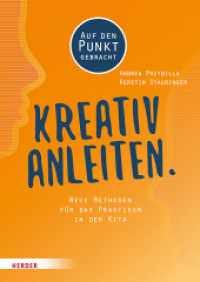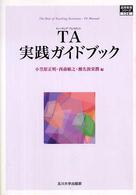- ホーム
- > 洋書
- > 英文書
- > Science / Mathematics
Full Description
This book delves into the critical intersection of waste management, bioenergy production, and the pursuit of a sustainable global future through the process of valorization. Waste valorization is the process of reusing, recycling, or composting waste materials and converting them into more useful products, including materials, chemicals, fuels, or other sources of energy. The urgent environmental issues surrounding the increasing accumulation of solid waste and the necessity to shift towards cleaner energy sources have led to a thorough investigation into the conversion of solid waste into biofuels and valuable chemical products.
This book compiles different dimensions of waste valuation for the sustainable environment, including a comprehensive description of the complex chemical composition of various types of municipal, agricultural, and industrial solid wastes, their potential as feedstock, their environmental impact, and conversion technologies. The book also covers challenges associated with waste management and green production technology for biofuel and chemicals from these wastes. The focus extends to evaluating the feasibility of these strategies on a large scale, assessing their economic viability, addressing challenges encountered in their implementation, and offering insights into the prospects of these innovative approaches. It further elucidates the life cycle assessment of the valorization of different waste types for biofuels and chemicals and the contribution of these wastes to the circular economy. The book examines cutting-edge technologies and methodologies for converting solid waste materials into biofuels, such as biodiesel, bioethanol, and biogas, and valuable chemical products along with each deterring factor, commercial feasibility, future perspective, economics, its environmental impact, and integral management policy.
This book serves as a guide for students, academics, researchers, policymakers, and industry professionals interested in the innovative and sustainable utilization of solid waste for the betterment of the environment and society.
Contents
Section 1 Municipal Solid Waste to Biofuels and Chemical Products.- Chapter 1.1 MSW as a feedstock for the production of biofuels and chemicals.- Chapter 1.2 Valorization of fruit waste to biofuels and chemicals.- Chapter 1.3 Vegetable waste as a low-cost source of biofuels and chemicals.- Chapter 1.4 Conversion of plastic waste to chemicals and biofuels.- Chapter 1.5 Valorization of food waste to chemicals and biofuels.- Chapter 1.6 Conversion of paper and packaging materials to biofuel and chemicals.- Chapter 1.7 Conversion of Poultry waste to Biofuel and chemicals.- Chapter 1.8 Conversion oil and fat waste to chemicals and biofuels.- Chapter 1.9. Challenges and Future prospects of conversion of MSW to biofuel and chemicals.- Section 2. Agriculture Solid Waste to Biofuels and Chemical Products.- Chapter 2.1 ASW as a feedstock for the production of biofuels and chemicals.- Chapter 2.2 Valorization of wheat residue to biofuels and chemicals.- Chapter 2.3 Rice Residue as a feedstock for biofuel and chemicals.- Chapter 2.4 Conversion of corn residue to chemicals and biofuels.- Chapter 2.5 Transfer of sawdust to chemicals and biofuels.- Chapter 2.6 Conversion of forestry waste to chemicals and biofuels.- Chapter 2.7 Millet waste as an inexpensive feedstock for biofuel and chemicals.- Chapter 2.8 Valorization of pulse waste to biofuel and chemicals.- Chapter 2.9 Challenges and Future prospects of conversion of ASW to biofuel and chemicals.- Section 3 Industrial Waste to Biofuel and Chemical Products.- Chapter 3.1 Valorization of petrochemical industrial waste to biofuels and chemicals.- Chapter 3.2 Transfer of textile industry waste to chemicals and biofuels.- Chapter 3.3 Conversion of pharmaceutical industry waste to chemicals and biofuels.- Chapter 3.4 Valorization of sugar industry waste to biofuel and chemicals.- Chapter 3.5 Utilization of Dairy industry waste for biofuel and chemicals.- Chapter 3.6 Valorization of leather industry waste to biofuel and chemicals.- Chapter 3.7 Pulp and paper industry waste as low-cost materials to produce biofuel and chemicals.- Chapter 3.8 Challenges and Future prospects of conversion of industrial waste to biofuel and chemicals.- Section 4 Life Cycle Assessment (LCA) for biofuels and chemicals from solid waste.- Chapter 4.1 LCA for the Valorization of Municipal Solid Waste to Biofuels.- Chapter 4.2 LCA for the Valorization of Municipal Solid Waste to chemicals.- Chapter 4.3 LCA for the Valorization of Agriculture Solid Waste to biofuel and chemicals.- Chapter 4.4 LCA for the Valorization of Agriculture solid Waste to chemicals.- Chapter 4.5 LCA for the Valorization of industrial solid Waste to biofuels.- Chapter 4.6 LCA for the Valorization of industrial solid Waste to chemicals.- Section 5 Solid Waste to Circular Bioeconomy.- Chapter 5.1 Contribution of MSW to Circular Bioeconomy.- Chapter 5.2 Contribution of ASW to Circular Bioeconomy.- Chapter 5.3 Contribution of ISW to Circular Bioeconomy.







